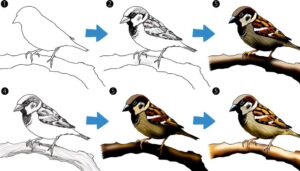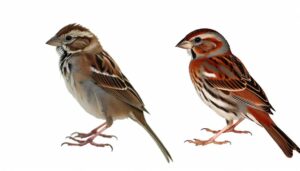Understanding Reasons for Belding’s Savannah Sparrow Decline
The decline of the Belding's Savannah Sparrow is mainly caused by habitat loss due to urban development and increasing sea levels. These factors disrupt the sparrow's food chain, lower survival rates, and reduce hatchling numbers.
Further intensifying their population decline are warmer temperatures and extreme weather events that negatively impact their insect prey and nesting. Heightened predation and diseases such as Avian malaria and West Nile virus also notably contribute to the issue.
Mitigating these threats calls for strong conservation efforts and targeted strategies, more about which unravel further down the line.

Key Takeaways
- Habitat loss due to urban development disrupts the Belding's Savannah Sparrow's food chain and increases nest predation.
- Climate change, including rising sea levels and warmer temperatures, affects the sparrow's food availability and habitat quality.
- Predation pressure on nests reduces offspring survival and contributes to the bird's population decline.
- Diseases such as avian malaria, West Nile virus, and avian pox pose significant health risks, leading to high mortality rates.
- Changes in the sparrow's plant communities, driven by climate change, impact the quality of its preferred salt marsh habitats.
Understanding the Savannah Sparrow
One must first comprehend the intricacies of the Savannah Sparrow's biology and habitat to grasp the factors contributing to its decline.
This species is a small, brown, streaky bird with a crisp, notched tail. It's known for its adaptable nature, surviving in various habitats, primarily open areas with low vegetation.
However, the Belding's subspecies is an exception, as it's specially adapted to salt marshes along the Southern California coast. It's uniquely built to handle high-salt diets, with larger kidneys and a salt gland for excreting excess.
Its nesting sites are in pickleweed, an integral part of its habitat. This bird's survival is intimately tied to the health of these marshes, which are currently under severe threat.
Historical Population Trends
Having recognized the intimate dependence of the Belding's Savannah Sparrow on its coastal marsh habitat, we can now turn our attention to the documented trends in its population over the years.
Significantly, it's been observed that:
- In the early 1900s, the sparrow was abundant across its range, indicating a healthy, flourishing population.
- By the mid-20th century, a substantial decline was recorded, raising conservation concerns.
- In the 1980s, it was classified as a Species of Special Concern due to the continued decrease in numbers.
- Recent surveys suggest a further, worrying decline, despite conservation efforts.
These historical shifts paint a stark picture of the sparrow's struggle to survive, setting the stage for a deeper exploration into the reasons behind this decline.
Impact of Habitat Loss
Undeniably, the loss and degradation of coastal marsh habitat plays a substantial role in the troubling decline of the Belding's Savannah Sparrow population. These sparrows are specialists, finely adapted to survive in the specific conditions of salt marsh ecosystems.
When these habitats are destroyed for urban development, agriculture, or water diversion, it doesn't just reduce the available area for nesting, it also disrupts their food chain. Insect populations, the primary food source for these birds, dwindle with the degradation of marsh vegetation. Nest predation rates increase as cover gets scarcer.
Each element of habitat loss contributes to a lower survival rate and fewer successful hatchlings, pushing the Belding's Savannah Sparrow towards a precarious future.
Climate Change Effects
In addition to habitat loss, the escalating effects of climate change pose a significant threat to the survival of the Belding's Savannah Sparrow. This bird species, endemic to the coastal salt marshes of Southern California and Baja California, is particularly vulnerable to rising sea levels. Increased tidal flooding compromises their nesting sites.
Warmer temperatures are another significant threat. These can alter the availability of their insect prey, impacting their food source and potentially leading to decreased reproductive success. Extreme weather events, such as unpredictable storms, can destroy nests and reduce survival rates, further endangering this species' population.
Changes in plant communities due to climate change also pose a risk to the Belding's Savannah Sparrow. Climate-induced shifts in vegetation can affect the bird's habitat quality, leading to potential food shortages and disruptions in nesting behaviors.
These climatic changes aren't mere projections but are observable realities threatening this species' existence. Their potential impact on the Belding's Savannah Sparrow's survival underscores the urgency of climate action.
Predation and Its Consequences
Predation also presents a grave risk to the Belding's Savannah Sparrow, with predators playing a pivotal role in the species' population decline. Predatory birds, mammals, and reptiles exploit the sparrow's nests, leading to reduced offspring survival.
Apart from direct predation, predators induce stress in the sparrows, affecting their feeding and breeding behaviours. The lurking threat of predation can cause sparrows to abandon their nests, leaving eggs and fledglings vulnerable.
This predation pressure has a cascade effect on the population dynamics, leading to a significant decrease in their numbers. The interplay of predation with other factors like habitat loss compounds the issue, pushing the Belding's Savannah Sparrow towards a perilous decline.
The Role of Pesticides
While predation poses a significant threat, it's the widespread use of pesticides that's also heavily impacting the decline of the Belding's Savannah Sparrow population. Pesticides, often utilized in agriculture, seep into the sparrows' habitats, contaminating their food and water sources. This leads to numerous deleterious effects, such as:
- Reduced reproductive success due to eggshell thinning and hormonal imbalance.
- Acute poisoning resulting in immediate death or long-term health complications.
- Disruption in the sparrow's food chain, leading to scarcity of insects, a primary food source.
- Bioaccumulation over time, where the concentration of pesticides in the sparrow's body increases, causing chronic health issues.
These factors, among others, illustrate the devastating role pesticides play in the declining sparrow population.
Invasive Species Threat
The threat of invasive species to the Belding's Savannah Sparrow can't be underestimated. These non-native creatures disrupt the sparrow's natural habitat, often outcompeting them for essential resources such as food and nesting sites.
The subsequent discussion will examine the impact of these invasive species and explore potential strategies to counteract their detrimental effects.
Impact of Invasive Species
Invasive species pose a vital threat to the Belding's Savannah Sparrow, disrupting their delicate ecosystems and challenging their survival. These intruders can have a profound impact in several ways:
- They might outcompete the sparrows for limited resources, such as food and nesting sites.
- Some invasive species are predators, posing a direct threat to the sparrows' safety.
- They can introduce novel diseases or parasites to which the sparrows have no immunity.
- Their presence can alter the habitat structure, making it less suitable for the sparrows.
The cumulative effects of these disruptions can lead to reduced sparrow populations and, in extreme cases, local extinctions. Understanding the specific impacts of invasive species is a pivotal step towards the conservation of the Belding's Savannah Sparrow.
Counteracting Invasive Threats
Efforts are underway to counteract the threats posed by invasive species to the Belding's Savannah Sparrow. The focus is primarily on habitat restoration, predator control, and disease management.
Habitat restoration involves reestablishing native vegetation that provides suitable nesting sites and food resources for the sparrows.
Predator control is vital to reduce the predation rates by invasive species such as rats and cats.
Disease management includes monitoring and controlling the spread of invasive diseases that could potentially harm the sparrows.
All these efforts require extensive research, careful planning, and constant monitoring to guarantee their effectiveness.
The ultimate goal is to create a balanced ecosystem where the Belding's Savannah Sparrow can thrive, contributing to the biodiversity and overall health of the environment.
The Disease Factor
Several factors contribute to the decline of Belding's Savannah Sparrow, and disease plays a significant role. These birds are susceptible to various diseases, some of which can have devastating effects on their populations.
The disease factor primarily includes:
- Avian malaria: This parasitic disease can cause high mortality rates in infected populations.
- West Nile virus: Transmitted by mosquitos, it can lead to severe neurological symptoms and death.
- Avian pox: A viral disease that can lead to growths and lesions on the bird's body, impairing their ability to fly or feed.
- Bacterial infections: Infections like salmonella can spread rapidly through a population, causing severe illness and death.
Understanding the disease's role in the sparrow's decline underscores the importance of maintaining healthy habitats to mitigate disease risks.
Conservation Efforts So Far
Efforts to conserve the Belding's Savannah Sparrow have been numerous and multifaceted, taking into account the various factors contributing to their decline.
Protection measures implemented so far have sought to mitigate habitat loss, address disease factors, and reduce predation.
As we shift focus to future conservation strategies, it becomes imperative to examine the effectiveness of these past efforts and identify areas for improvement.
Implemented Protection Measures
Over the years, conservationists have implemented various protective measures to curb the decline of the Belding's Savannah Sparrow, with a notable focus on habitat restoration and preservation.
Key actions include:
- Establishing protected areas to preserve the sparrow's natural habitat, primarily coastal salt marshes.
- Implementing strict regulations against disturbance of these habitats, particularly during nesting periods.
- Encouraging public awareness and education about the bird's habitat needs and threats.
- Initiating research projects to better understand the sparrow's ecology and the impacts of environmental changes.
These measures aim to safeguard the Belding's Savannah Sparrow's survival by ensuring a safe, secure environment. However, while significant, these actions are a starting point.
A continuous, concerted effort is crucial to sustain the bird's population and prevent further decline.
Future Conservation Strategies
Despite the progress made in the protection of Belding's Savannah Sparrow, there's an immediate need to adopt more proactive, forward-looking conservation strategies to secure the bird's long-term survival. These strategies should focus on habitat preservation, as habitat loss is the primary cause of the species' decline.
Efforts must be made to protect and restore coastal marshland ecosystems, the bird's natural habitat. Additionally, the introduction of predator control programs can help safeguard the sparrow from non-native predators. Public education is also vital to promote awareness and support for the bird's plight.
Future Outlook and Solutions
The potential for recovery of the Belding's Savannah Sparrow population hinges on the implementation of strategic conservation efforts aimed at habitat preservation and restoration.
To guarantee the survival of this species, several key measures must be taken:
- Reestablishment of coastal salt marshes, the natural habitat of the sparrow, through careful ecological engineering.
- Strict regulation of encroaching human activities that disrupt the bird's nesting and feeding patterns.
- Implementation of captive breeding and release programs to bolster population numbers.
- Public education on the importance of biodiversity and the role the sparrow plays in maintaining balance in the ecosystem.
These solutions are the foundations upon which the Belding's Savannah Sparrow's future rests. Without concerted efforts in these directions, this unique bird may soon be a memory of a more diverse past.
Conclusion
In a twist of irony, the Belding's Savannah Sparrow faces threats similar to our own existence. Habitat loss, climate change, and invasive species aren't just sparrows' plight, but ours too. Their decline is a grim mirror to our environmental missteps.
Yet, optimism persists. Conservation efforts are underway to combat these issues, reflecting our own resilience. Their struggle for survival mirrors our fight for a healthier planet – a poignant coincidence that underscores our interconnected fates.





